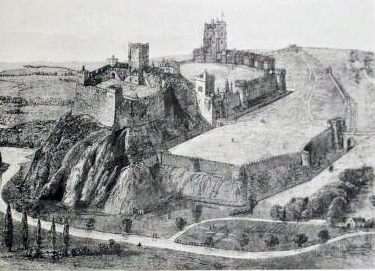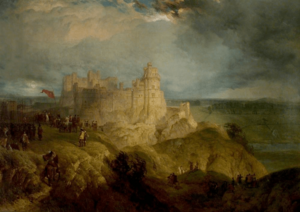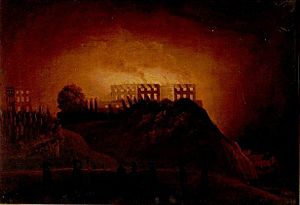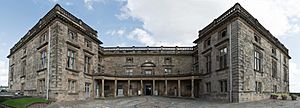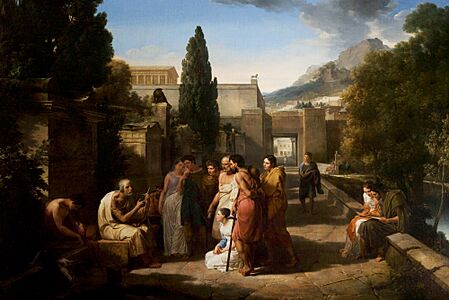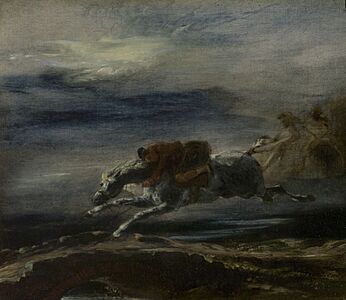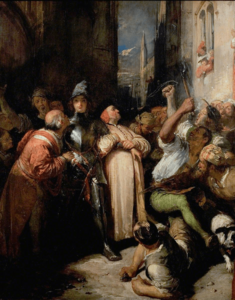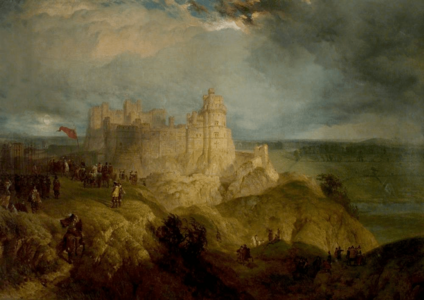Nottingham Castle facts for kids
Quick facts for kids Nottingham Castle |
|
|---|---|
| Nottingham, England | |
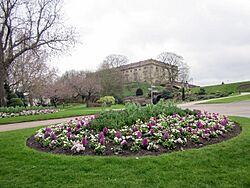
Nottingham Castle and gardens
|
|
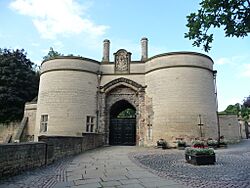
The Castle Gate House shows the medieval architecture of the bridge and lower towers against the Victorian renovation of the upper towers and gate house
|
|
| Coordinates | 52°56′57″N 1°09′17″W / 52.9493°N 1.1546°W |
| Type | Enclosure castle |
| Site information | |
| Owner | Nottingham City Council |
| Official name: Nottingham Castle | |
| Reference #: | 1006382 |
|
Listed Building – Grade I
|
|
| Official name: Nottingham Castle Museum | |
| Designated: | 11 August 1952 |
| Reference #: | 1271188 |
| Controlled by | Nottingham Castle Trust |
| Site history | |
| Built | 1068 |
| Built by | William the Conqueror The 1st Duke of Newcastle |
| In use | Museum and art gallery |
| Events | English Civil War 1831 reform riots |
Nottingham Castle is a famous landmark in Nottingham, England. It stands on a high rock called "Castle Rock," which looks over the city. The first castle was built here by the Normans in 1068. Over many years, it grew into an important royal fortress.
By the 16th century, the original castle was falling apart. After the English Civil War in 1651, most of it was torn down. Later, in the 1670s, a grand house called a "ducal mansion" was built on the same spot. This mansion was burned down by rioters in 1831.
The mansion was left in ruins until the 1870s. It was then fixed up and turned into an art gallery and museum, which is still open today. Not much of the original castle remains, except for its gatehouse and some parts of the old walls.
The castle is owned by Nottingham City Council. It had a big renovation that finished in 2021. It closed again briefly in late 2022 but reopened in June 2023.
Contents
History of Nottingham Castle
The First Castle: Medieval Times
The very first castle on Castle Rock was made of wood. It was built in 1068 by William the Conqueror, just two years after the Battle of Hastings. Later, during the time of King Henry II, this wooden castle was replaced with a strong stone one. This stone castle was very impressive and had different sections, including an upper part, a middle part with royal rooms, and a large outer area.
For hundreds of years, Nottingham Castle was one of the most important castles in England. It was in a great spot near the River Trent. It was also a fun place for kings and queens because it was close to royal hunting grounds like Sherwood Forest. The castle even had its own deer park nearby.
When King Richard I (also known as "the Lionheart") was away on a crusade, his brother Prince John and his supporters took over Nottingham Castle. In the famous stories of Robin Hood, the castle is often shown as the place where Robin Hood and the Sheriff of Nottingham had their final battles.
In March 1194, King Richard I returned and besieged Nottingham Castle to take it back from Prince John's supporters. He used special machines, like those used in crusades. The castle surrendered after only a few days.
A dramatic event happened at Nottingham Castle in 1330. King Edward III, who was almost 18, secretly entered the castle through a hidden tunnel. He was with his trusted friends. They surprised his mother, Isabella of France, and her lover, Roger Mortimer, 1st Earl of March, who were ruling England for Edward. Mortimer was arrested and later executed. This event marked the start of Edward III's own rule.
A Royal Home and Fortress
Edward III often used the castle as a home and held important meetings there. In 1346, David II of Scotland, the King of Scotland, was held prisoner at the castle. Edward III also added new parts to the castle, like a new tower and a prison.
Later, King Richard II also used the castle for important meetings. From 1403 to 1437, it was the main home for King Henry IV's queen, Joan of Navarre.
After Joan lived there, the castle wasn't kept up as well. But during the Wars of the Roses, it became important again as a military base. Edward IV ordered new royal apartments to be built, which were described as very beautiful.
By the time of Henry VIII, the castle was still a royal fortress. However, reports from 1525 and 1538 said that many parts of the castle were falling into "decay and ruin." In 1536, the castle's defenses were strengthened with a new drawbridge and more soldiers.
The English Civil War
By the 1600s, the castle was no longer a royal home and was becoming old-fashioned for warfare because of new cannons. When the English Civil War began in 1642, King Charles I chose Nottingham as a meeting point for his army. But soon after he left, the castle was taken over by Parliament's forces.
The Parliamentarians, led by John Hutchinson, defended the castle against attacks from the King's army. They were the last group to hold the castle. In 1651, two years after King Charles I was executed, the castle was completely destroyed. This was done to stop anyone from using it as a fortress again.
Building the Ducal Mansion
After King Charles II returned to the throne in 1660, a new grand house was built on the castle site. This was the "Ducal Mansion," built for the 1st Duke of Newcastle. It was finished by his son. This new palace was considered one of the most beautiful in England at the time.
Even though the old castle was destroyed, some parts of it still exist beneath the mansion. There are rock-cut cellars and old arches. There's also a long secret passage called Mortimer's Hole, which you can explore on guided tours.
The mansion was designed in a style called "Italianate," which was very grand. However, as the city of Nottingham grew with factories and became very busy, the dukes lost interest in living there. In 1831, people who were upset about politics rioted and burned down the mansion.
The Castle Becomes a Museum
The mansion was left as a burnt-out shell until 1875. It was then rebuilt and opened in 1878 as the Nottingham Castle Museum. It was one of the first public art galleries in the UK outside of London. The new museum had a large picture gallery, like the famous Louvre museum in Paris.
The old gatehouse and parts of the medieval castle walls were kept and used as garden walls for the new mansion. In 1939, during the Second World War, the British Army took over the castle and used it to store supplies. It was given back to the city in 1946.
In 1996, a part of the castle rock collapsed due to a leaking water pipe. This revealed some of the original castle foundations. The area was later repaired, and the terrace now offers great views of the city.
For many years, a drawing of the Ducal Mansion was shown on millions of packets of cigarettes made by a Nottingham company called John Player & Sons.
Recent Renovation and Reopening
Nottingham Castle closed in 2018 for a big renovation project that cost £30 million. It reopened in June 2021. The renovation added a new visitor center, interactive displays, and a special adventure area for children in the old castle moat, themed around the time of Robin Hood. It also shows off local industries like Nottingham Lace.
After reopening, the castle faced some challenges, including criticism about the entrance fee and other issues. In November 2022, the group running the castle announced it was closing again due to financial problems. However, the Nottingham City Council took back control, and the castle and its grounds reopened to visitors in June 2023. It is now run as part of the city council's museums.
Nottingham Castle Museum and Art Gallery
The ducal mansion is home to the Nottingham Castle Museum and Art Gallery. It displays many important art pieces and historical items from Nottingham and the surrounding areas. It also has the museum for the Sherwood Foresters, a local army regiment.
Some of the interesting things you can see in the collections include:
- Old carvings from the 15th century made of Nottingham alabaster.
- Watercolour paintings by artists like Richard Parkes Bonington and Paul Sandby.
- A collection of Wedgwood pottery.
- Modern ceramics and old salt-glazed pottery.
- A collection of costumes, including examples of Nottingham lace.
- Roman offerings from an ancient temple.
- Artworks by famous British and European artists.
There is also a memorial dedicated to people from Nottinghamshire who received the Victoria Cross, a very brave award.
Gallery
-
Ruins of the Abbey Saint Bertin by Richard Parkes Bonington, 1824
-
Tam O'Shanter by Eugène Delacroix, 1825
-
The Château of the Duchess of Berry by Richard Parkes Bonington, 1825
-
Quentin Durward at Liège by Richard Parkes Bonington, 1828
-
Robin Hood and His Merry Men Entertaining Richard the Lionheart in Sherwood Forest by Daniel Maclise, 1839
See also
 In Spanish: Nottingham Castle para niños
In Spanish: Nottingham Castle para niños
- History of Nottingham
- Grade I listed buildings in Nottinghamshire
- Listed buildings in Nottingham (Radford and Park ward)



